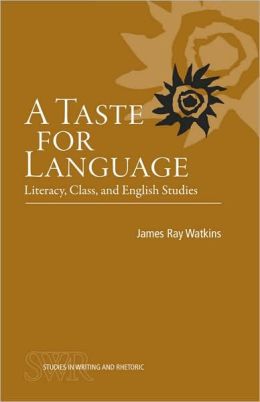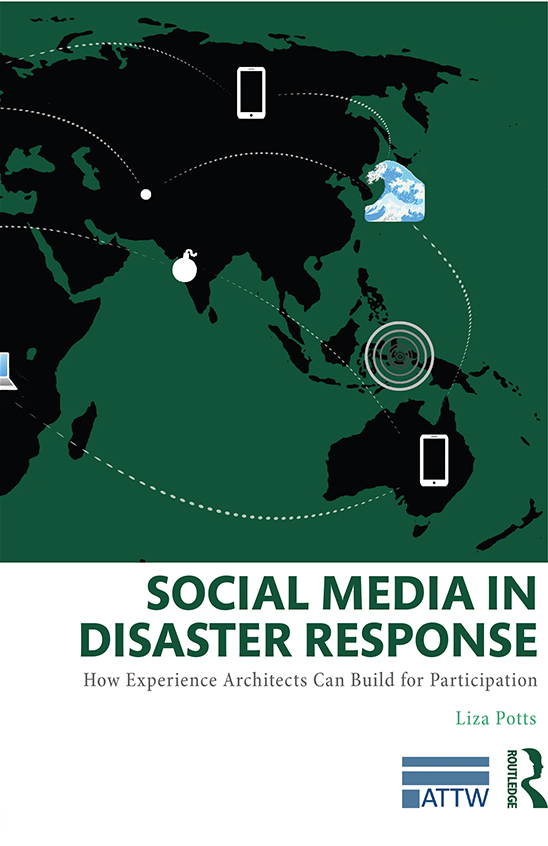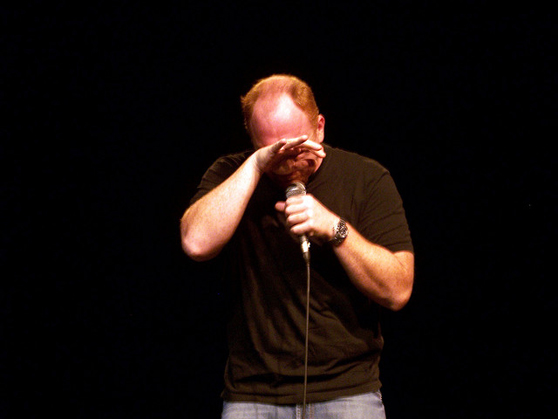Book Review: Watkins’ A Taste for Language
Watkins, James Ray, Jr. A Taste for Language: Literacy, Class, and English Studies. Carbondale: Southern Illinois UP, 2007. Print.
A growing number of composition theorists (Hooks; Peckham) have noted the relative lack of discussion of social class in our field. James Ray Watkins Jr.’s A Taste for Language: Literacy, Class, and English Studies provides a theory of “middle class”  language production for post-WWII education and reformulates a responsible cultural capital in the 21st century world outside the university. Watkins provides a multigenerational family autobiography to construct a revisionist history of composition studies that supports the proposed 21st century forms of cultural capital. To his credit, Watkins also provides a pedagogy to achieve this new cultural capital, although his “writing in the wild” pedagogy may not be as groundbreaking as a theory pressing for new cultural capital would demand. That said, A Taste for Language is a welcome addition to the discussions of social class in composition and the future of English and composition studies.
language production for post-WWII education and reformulates a responsible cultural capital in the 21st century world outside the university. Watkins provides a multigenerational family autobiography to construct a revisionist history of composition studies that supports the proposed 21st century forms of cultural capital. To his credit, Watkins also provides a pedagogy to achieve this new cultural capital, although his “writing in the wild” pedagogy may not be as groundbreaking as a theory pressing for new cultural capital would demand. That said, A Taste for Language is a welcome addition to the discussions of social class in composition and the future of English and composition studies.
To open the book, Watkins suggests that we must revise the assumption that education automatically provides movement up the meritocratic ladder. English studies must reassess composition and literature, “the relationship between ethos and aesthetics” (5), as well as epistemological assumptions of our work inside and outside the university. We should think of our work much like the hole in the ozone: “the ‘hole in the ozone’ . . . cannot be accounted for by or through adherence to disciplinary and academic divisions and boundaries; it is about physics as much as sociology, economics as much as psychology” (8). Watkins ends the introduction with a question: “What do [citizens and employees] take away from their college classes in English?” (12).
To answer this question, Watkins turns to his family history. Each chapter is laced by a lengthy personal narrative of Watkins’s WWII veteran farming father who attended college through the GI Bill, who dreamed of being a lawyer but chose the practical degree and career of a municipal civil engineer. By documenting, remembering, and imagining his father’s literacy practices at work and at home, Watkins develops a multigenerational case study that explores the cultural capital that writing and literature instruction provided his father at work and at home. Watkins recovers his father’s undergraduate curriculum at LSU during the 1950s and rethreads the writing and literature courses through the lens of his father’s vocational and socioeconomic reasons for attending college.
Watkins focuses on a lengthy analysis of his father’s university textbook, Unified English for Composition. The analysis details connections to current-traditional rhetoric, and Watkins identifies the book’s epistemological assumptions of language as objective and transparent. This allows him to connect the book to both technocratic and meritocratic views of language that promote objectivity, clarity, and distrust of persuasion, which Watkins views as requirements for ascending to a 1950s and 1960s middle-class career and life. Watkins also identifies in his father’s textbook much indirect commentary that suggests that “hard work,” through writing or otherwise, will provide one with meritocratic access—but only if one engages in social convention when interpreting language.
Watkins then close reads a variety of his father’s workplace writings to illustrate how his father performed these epistemological assumptions of objectivity, including distrust of persuasion, to translate his English education into middle-class cultural capital. The chapter makes a final turn in a section titled “The Silence of the Middle Class,” wherein Watkins demonstrates that this view of language and literacy effectively silenced democratic voice as part of the American Dream or class mobility. Watkins sums up this idea by suggesting that “middle-class status is by definition an ongoing process, less teleology of material success than an evolution of sensibility” (42), whether in past views of language’s transparency or in our current views of language as ideological and in need of critical analysis.
Chapter 2 follows this line of thought to a revised view of cultural capital. Readers interested in the effects of market and economic rhetorics will find useful historiography here, as Watkins evaluates the collusion between 1950s universities’ newfound riches, textbook marketing strategies, and middle-class values. This forces a revised history away from popular rhetoric and literature historiographies, which, Watkins intones, typically focus on disciplinary esteem.
Watkins introduces Bourdieu’s “cultural capital” to demonstrate the economy, value, and accumulation of literature (the aesthetic) and writing (ethos) that are in “dynamic tension” (69). Watkins writes that “[a]esthetic values . . . can serve as markers of class status because to some degree they are dependent on the accumulated cultural capital—the education in both formal and informal senses . . . ” of what Watkins refers to as “taste.” Watkins zeroes in on a new way of explaining our contemporary loss of the aesthetic as cultural capital. He opines that “literally, few people have the surplus time or energy necessary for the accumulation of a distinctly aesthetic sensibility, either with or without the assistance of school” (68). This new explanation goes far, although Watkins never includes the location or stake of new or class-based forms of aesthetic cultural capital.
Chapter 3 takes on “Dad’s Tastes,” his father’s cultural capital in various forms. Watkins frames the discussion with personal memories of his father’s discomfort with middle-class tastes such as golf, recreational biking, and business associations. His father’s discomfort with the tastes of middle-class life becomes the chapter’s focus, a revised history of Cleanth Brooks and the New Critics’ mid-century influence on noninstrumentalist language instruction. Watkins reverses typical histories of the New Critics as creating a scientific and objective view of literary analysis and meaning. Watkins argues that “Brooks saw his students’ assumptions about language as founded in a resilient popular ethos. . . . In this sense, Brooks’[s] pedagogy is a sophisticated counterweight to the rise of objective, scientific epistemology” (79). Watkins spends the chapter deftly unpacking this argument through Brooks’s popular composition textbook and educational writings. From this view, Brooks sought to teach differentiation and appreciation of language, to avoid the “pressures toward direct statement” (Brooks qtd. in Watkins 85), and to attend to the representation, not to the thing represented (86).
This revised history moves toward “a reversal of our traditional institutional understanding in which the popular ethos . . . is seen in terms of an ongoing, productive dialectic with a formal aesthetic” (95). For Watkins, a new framework requires that literature and composition break out of disciplinary histories where literature and composition are discussed only as a purposeful dialectic. Rather, English studies must be attentive to “the place and purposes of a specifically literary form of cultural capital” (95).
Chapter 4 brings us into the present and future, where rhetoric and composition’s messages of the non-transparent, ideological views of language are increasingly challenged by vocationally minded publics. For this reason, too, composition needs to explore cultural capital outside the university. Watkins then begins a selective, narrow review of mildly post-process literature. Watkins questions how we can validate our truisms if we do not let students “test and refine these principles outside their particular classroom” (128). This is true, but I would suggest that the author neither engages with the multitude of qualitative research available from the fields of technical and professional writing case studies or the stalwart books on service-learning (Adler-Kassner, Crooks, and Watters; Deans) nor includes research in transfer studies that focuses on students transitioning from the university to the workplace—Worlds Apart by Patrick Dias, Aviva Freedman, Peter Medway, and Anthony Pare, for example. In essence, Watkins does not review current research on students writing outside the classroom. Instead, he too easily assumes that neither the research nor the student writing is happening.
The chapter evolves into an argument that English studies should not demonize vocationalism. Watkins contends that the “skills and abilities” of instrumental language are best understood as “the responsibilities and practices of readers and writers” (118) and are part of our charge. In valuing aesthetics over instrumentalism, we denature the connection of both literature and composition to socially practiced forms of cultural capital, and we fetishize both aesthetics and instrumentalism. While I agree, Watkins’s sustained focus on the literature-composition binary and its attendant literature can be seen as harming his potential to say more about what forms of capital workplace writers are actually using. The ethnographic research of Deborah Brandt, for instance, seems an appropriate assessment of workplace literacy and cultural capital, but Watkins’s shepherding of his revisionist conversation marginalizes much ethnographic real-world research.
The chapter closes with Watkins introducing his pedagogy, “writing in the wild.” The pedagogy is based upon cognitive anthropologist Edwin Hutchins’s Cognition in the Wild. The pedagogy seeks to track mental processes in real-world situations and sees all writing as situated. While the pedagogy is a natural extension of Watkins’s cultural capital argument, I found myself wondering yet again why neither the staples of post-process theory nor of sociocognitive composition, such as Carol Berkenkotter and Thomas Huckin’s Genre Knowledge in Disciplinary Communication, rife in theory and qualitative study, are not included to better situate Watkins’s ideas of cultural capital and the mental processes of real-world writing. In a highly pragmatic turn, Watkins details his classroom, which involves a high degree of students collaborating through email and other workplace technologies as well as a large dose of self-study and ethnography that allows students to explore the “dimensions . . . and distributed nature of knowledge” and knowledge making (134). While this is pedagogically sound, the pedagogy does not capture the book’s major premise, cultural capital in use outside the university, and, with no inclusion of the mass of existing research on nonacademic writing, “writing in the wild” seems more of a recap of a call for something akin to service-learning than a new approach to teaching writing.
The final chapter places Watkins’s revised history alongside other disciplinary histories that trace disciplinary self-interest, various metaphors that publics use to define literacy, and the pressures on and resources of English studies. Watkins finds that these public arguments also define cultural capital through simple, non-transformative lenses; thus, the arguments do not produce a reformed curriculum, and a rift between the university and the real world continues. In the closing pages, Watkins makes a strong claim that composition research should investigate the connection between cultural capital and class. Here, Watkins goes beyond the limits of qualitative workplace composition research. His suggestion, I imagine, is that we must not only study the transfer of critical thinking and rhetorical training, but we must also track the reception of writing and the writer in the workplace and public.
In closing, the book’s inclusion of social class in pedagogy and history is an important step forward for composition studies. While Steve Parks chronicled “Students’ Rights to Their Own Language” as a class-based event, Parks focused instead on empowering students while in the university. Recently, Irv Peckham has argued that we do not know enough about the sociolinguistics of working class students and the effects of their instrumentalist approaches to language and critical thinking in college classrooms. Watkins contributes to social class theory by basing his revisionist history on non-English majors and by seeing our capital not in decline inside the university but as a provider of developing forms of cultural capital outside the university. If the book has a major weakness, then it is the lack of identification of what cultural capital could or should look like. Research on workplace writing is missing, as is research on the public sphere. The book lays no path or framework to begin investigating new forms of cultural capital. Watkins never provides locations of place (public or workplace) or material (technology) that seem important to class advancement. This could be an oversight, given the lack of material, economic, and political power owned by working class and working poor populations and the schools they pass through. Without inclusion of particular capital or a data-gathering project, only theorizing remains, and one wonders whether this is enough to save English studies or those of middle-class aspirations that pass through our classrooms.
I believe A Taste for Language would be an excellent addition to practicum or themed courses at the advanced undergraduate and/or graduate level because the book is highly readable, provides detailed context, and does not assume too much disciplinary knowledge. The large doses of autobiography will clearly help students contextualize the disciplinary historiography and cultural theoretical discussions. Both the theorist and instructor will find that Watkins ultimately breaks new ground by asking and beginning to answer an important question less addressed in previous writing on social class: in the 21st century, what does middle-class literacy and cultural capital look like?
Works Cited
- Adler-Kassner, Linda, Robert Crooks, and Ann Watters, eds. Writing the Community: Concepts and Models for Service-Learning in Composition. Washington: American Assn. of Higher Education/NCTE, 1997. Print.
- Berkenkotter, Carol, and Thomas N. Huckin. Disciplinary Knowledge in Communication: Cognition/Culture/Power. Mahweh, NJ: Lawrence Erlbaum, 1995. Print.
- Brandt, Deborah. Literacy in American Lives. Cambridge: Cambridge UP, 2001. Print.
- Deans, Thomas. Writing Partnerships: Service Learning in Composition. Urbana: NCTE, 2000. Print.
- Dias, Patrick, Aviva Freedman, Peter Medway, and Anthony Pare. Worlds Apart: Acting and Writing in Academic and Workplace Contexts. Mahweh, NJ: Lawrence Erlbaum, 1999. Print.
- Hooks, Bell. Where We Stand: Class Matters. New York: Routledge, 2000. Print.
- Parks, Steve. Class Politics: The Movement for Students’ Rights to Their Own Language. Urbana: NCTE, 2001. Print.
- Peckham, Irvin. Going North, Thinking West: The Intersections of Social Class, Critical Thinking, and Politicized Writing. Logan: Utah State UP, 2010. Print.




 Liberty Kohn is an assistant professor of English at Winona State University. His scholarship appears in a variety of journals and collections including Composition Forum, the Journal of Language and Literacy Education, Technoculture, and Digital Assignments for the Literature Classroom (forthcoming, Bedford/St.Martin’s). His research and teaching interests include public writing, genre theory, mentoring tutors and teaching assistants, and Buddhist poetics and rhetoric. His recent work specializes in developing heuristics to identify links between economic injustice and social injustice. He often serves as writing center director and WAC coordinator.
Liberty Kohn is an assistant professor of English at Winona State University. His scholarship appears in a variety of journals and collections including Composition Forum, the Journal of Language and Literacy Education, Technoculture, and Digital Assignments for the Literature Classroom (forthcoming, Bedford/St.Martin’s). His research and teaching interests include public writing, genre theory, mentoring tutors and teaching assistants, and Buddhist poetics and rhetoric. His recent work specializes in developing heuristics to identify links between economic injustice and social injustice. He often serves as writing center director and WAC coordinator.